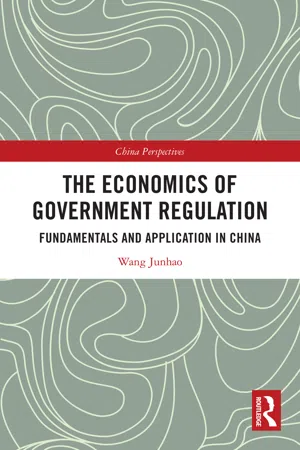Regulation is a unique public product imposed by a government on society. The main task of this chapter is to use analytical approaches of microeconomics to explain and analyze the supply and demand of government regulation and its equilibrium, along with the causes of this demand and the means of providing the regulation. Moreover, the costs and benefits of regulation will be examined, providing an analytical tool to assess the economic rationality of regulation.
Regulation as a unique public product
Government regulation is a contested concept. Alan Stone defines it as a state-imposed limitation on the possible decisions by individuals or organizations, which is effective owing to the threat of sanction.1 W. Kip Viscusi et al. highlight the power to coerce, for the same purposes as Stone proposes.2 For Daniel F. Spulber, regulations consist of general rules or special actions imposed by administrative authorities that either intervene directly with the market allocation mechanism or indirectly by altering consumer and firm demand and supply decisions.3 Masu Uekusa defines it as an action performed by public institutions to restrict the activities of firms according to certain rules, where the public institutions or administrative authorities are generally referred to as “government.”4
Based on this survey, we contend that regulation is a combination of various incentive and restrictive behaviors toward micro-market entities (mainly firms) by government agencies using certain laws, regulations, systems, and a broad range of regulatory methods, in pursuit of public interest. In a market economy system, regulators are supposed not only to restrict firms from certain activities, but also encourage them to improve productive efficiency. Then the lower prices enjoyed by consumers and the incremental gains achieved by firms yield higher social welfare.
The discussion of regulation may be summarized as follows: (1) the subject of regulation is government agencies with regulatory functions (hereinafter referred to as “the government” in this book), which are granted regulatory powers through legislation or other forms and often play the role of “regulators”; (2) the object of regulation is various micro-market entities (mainly firms), which are often referred to as the “regulated entities”; and (3) government’s regulation power is wielded through regulation of various forms, which precisely stipulate the mandates that the regulated entities must be subject to and define the way to control and impose sanctions against violations.
Chief among the three components of the concept of government regulation is policy. It may take the form of laws (such as the Telecommunications Act and the Electric Power Act), or less powerful rules, regulations, and local government policies. Whether laws or normative documents, they are all formulated by the government and have considerable coercive power.
From the perspective of institutional economics, these laws and normative documents are essentially public products. As previously stated, government regulation as a public product is not directed at any specific market entity, but instead at every entity. It is not exclusive in its application and applies to all regulated actors. However, it is unique as compared with other general public products in terms of the following three attributes.
First, a general public product is tangible and physical (such as parks, roads, bridges, and lighthouses), while government regulation is intangible and is represented by legal systems and other rules. It is also flexible and can be subjective in its implementation.
Second, a general public product does not have to be provided only by the government. It may also be provided by private donors (firms or individuals) or supplied competitively by private players through franchise bidding. However, the right to supply government regulation is monopolistic in its nature and is exclusive to the government.
Third, a general public product can provide diverse types of consumers with basically the same benefits. For example, the scenic West Lake in Hangzhou, China, attracts tourists from different countries, thus making a contribution to international tourism. However, government regulation is influenced by such factors as values, ideology, and political systems. It has a certain “regional specificity,” i.e., regulation that is considered to be successful in one country may not be appropriate in another country. Therefore, no one country can copy a regulatory model from another wholesale. Meanwhile, from a microscopic standpoint, regulations will have different effects on different interest groups, which may be beneficial to some while unfavorable to others.
Then based on regulation’s uniqueness, we can use economic principles to analyze the supply and demand of government regulation and its subsequent equilibrium, identify its costs and benefits, and explore effective ways to enhance regulatory efficiency.

